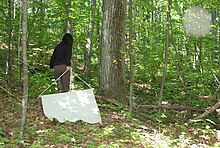Tick dragging: Difference between revisions
(edited with ProveIt) |
(No difference)
|
Revision as of 04:06, 6 September 2011
Tick dragging is a popular method for collecting ticks used by parasitologists and other researchers studying tick populations in the wild.

Method
To conduct a tick drag, a researcher uses a strip of 1-m2 white cloth, usually corduroy, mounted on a pole that is tied to a length of rope. The researcher drags the cloth behind him or her through terrain that is suspected of harboring ticks, working in a grid-like pattern. He or she may also "flag" low-lying bushes and other vegetation by waving the cloth over them.[1]
Though somewhat rudimentary, tick dragging is considered to be the most effective method of harvesting wild ticks for study in the lab. In at least one trial, the tick dragging method proved more successful than more technologically innovative techniques, such as live-baited traps and CO2-baited traps.[2]
History
The practice of dragging a large white cloth across suspected tick-infested terrain is described in biological field guides from the early 20th century.[3] Since then, the practice has proven to be simple and effective enough to stand the test of time.
References
- ^ "Monitoring and Thresholds for Ticks". NPS on the Web. National Park Service, US Department of the Interior. 01/19/2010. Retrieved September 05, 2011.
{{cite web}}: Check date values in:|accessdate=and|date=(help) - ^ Falco, Richard C. and Durland Fish (1992). "A comparison of methods for sampling the deer tick,Ixodes dammini, in a Lyme disease endemic area". Experimental and Applied Acarology. 14 (2): 165–173. doi:10.1007/BF01219108.
- ^ William Anson Hooker; F. C. Bishopp; Herbert Poland Wood (1912). The life history and bionomics of some North American ticks. U.S. Dept. of Agriculture, Bureau of Entomology. p. 9. Retrieved 5 September 2011.
{{cite book}}: Unknown parameter|coauthors=ignored (|author=suggested) (help)
